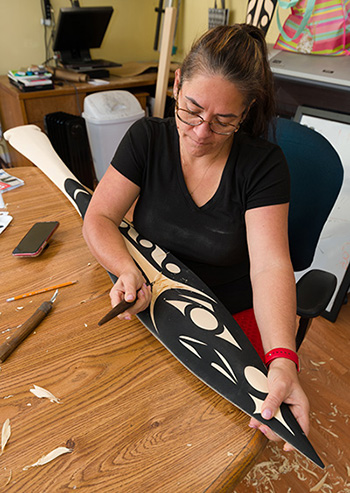Published by 4Culture on
Andrea Wilbur-Sigo: Reflection + Metamorphosis
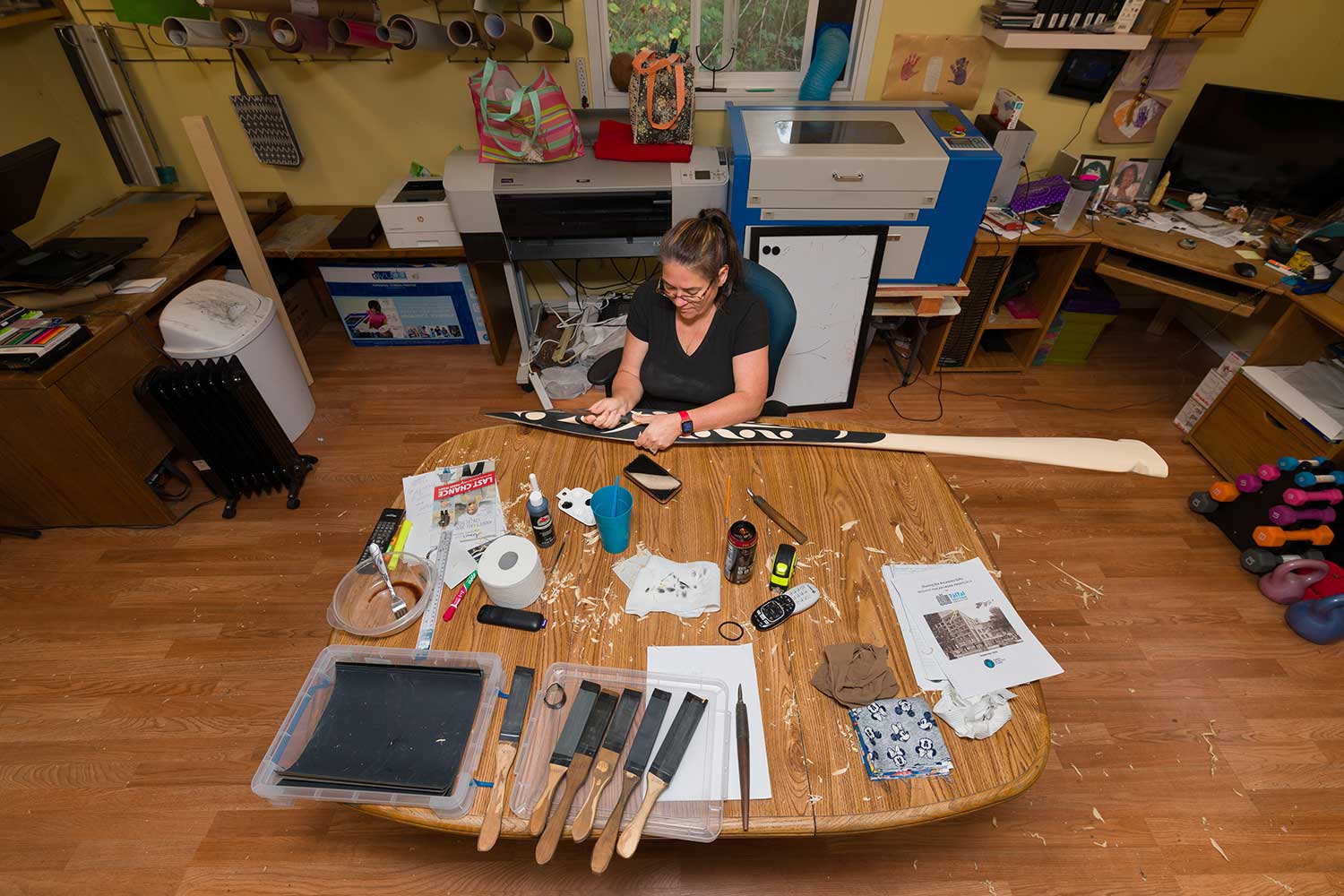
Science, art, design, and ecology come together at Brightwater, one of the largest wastewater treatment facilities in the world. Located north of Woodinville, WA, the property includes a park, a community gathering space, an exhibition hall, and a scientific learning laboratory in addition to the structures that house technical operations. Throughout the site, integrated and portable artworks highlight the science of the treatment processes, illuminate the history of the place, and reveal the role of people in the lifecycle of water.
The foreground landscape, visible from the street, features Andrea Wilbur-Sigo’s Grandfather’s Wisdom, which celebrates the perspectives and aquatic culture of the Squaxin Island Tribe and the First Peoples of Puget Sound.
“This [artwork] represents in a modern view what a longhouse would look like standing in a place that it's highly likely one might have been,” says Andrea, the first documented woman carver in her tribe and native family.
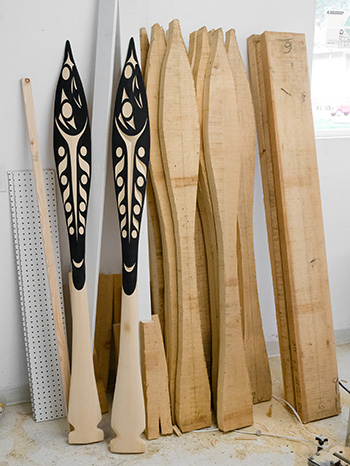 The longhouse’s carved motifs of Killer Whale, Octopus, and Thunderbird are creatures of universal significance among Coast Salish tribes. Made of old-growth cedar, it is flanked by a series of twenty upright paddles—an homage to the practice of “paddles up,” which signals a desire to land and visit when approaching a community by canoe. Salmon imagery on the paddles acknowledges the historical importance of the fish to Native peoples, as well as the restored habitat and improved connection to Little Bear Creek made possible by Brightwater.
The longhouse’s carved motifs of Killer Whale, Octopus, and Thunderbird are creatures of universal significance among Coast Salish tribes. Made of old-growth cedar, it is flanked by a series of twenty upright paddles—an homage to the practice of “paddles up,” which signals a desire to land and visit when approaching a community by canoe. Salmon imagery on the paddles acknowledges the historical importance of the fish to Native peoples, as well as the restored habitat and improved connection to Little Bear Creek made possible by Brightwater.
We recently worked with Andrea who, in collaboration with her partner Steve Sigo, reimagined these paddles in carved and painted cedar to complement the longhouse and better reflect her traditional vernacular and working style, replacing cast concrete designs fabricated and installed in 2012. Photographer Joe Freeman documented each phase of the project, at Andrea’s studio in Shelton, WA and at Brightwater.
Stewardship is one of the primary responsibilities of the public art team at 4Culture. Tasked with the care and keeping of more than 2,500 artworks that comprise King County’s Public Art Collection, we work alongside artists as well as specialized conservators and technicians every day to clean, restore, and revitalize these cultural assets and ensure their longevity.
Selina Hunstiger, Public Art Project Manager, sat down with Andrea to discuss and reflect on the importance of materials, mentorship, and intentionality.
Grandfather’s Wisdom, the title of your artwork, is a direct reference to lineage. Could you explain its origin and meaning? Also, how does family play a role in your work?
Grandfather’s Wisdom is a legend we have in our tribe that has to do with an octopus watching over all of his grandbabies, a storm coming in, and him trying to get his babies home safe. He raises his tentacles and flaps them to get the phosphorescence (which are the underwater stars) to light up the underwater world and bring them home. Really, it tells the story of what we have to do as people - we have to make the way and make sure that what we’re doing is only going to affect our grandbabies in the best light. Every choice we make has an impact on them, whether we realize it or not. We’ve always said, you know, that we think of the 7 generations, and thinking about them now as a grandma myself, we even think beyond that.
My grandpa had an impact on me and left me enough information to help me become me. He got out of his comfort zone to work with Myron Mills and William Elmendorf to document our stories and to document who my family is and where we came from. And because he did that, in a time that it wouldn’t have been typical to happen, he left that knowledge for me and all of his grandkids (and trust me, he had 21 kids, and there's hundreds of us grandkids)... and it made a path for me. And now I like to say that everything I do is making a path for my grandkids. Yes, they will have their own struggles, but they're hopefully not going to have my struggles, they're going to have their own. So, all these stories that we have are not just old legends, they’ve metamorphosized into something that is relevant today…
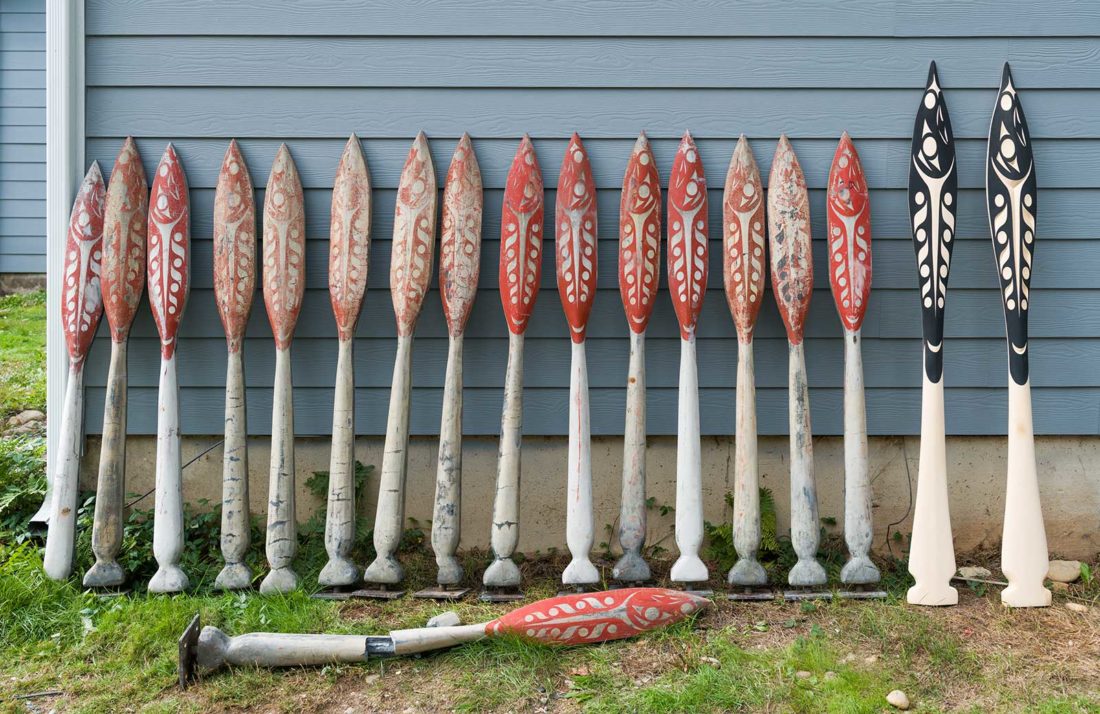
And, my kids, they play a role every day - sometimes it's cooking, sometimes it's cleaning or it's babysitting the next kids. It’s is out here in the shop... all of my kids are artists. When I'm in the middle of doing a project, I throw my kids a paintbrush along with me, and I tell them, you're going to help with this. And every one of them has told me the same thing, “I can't do that mom” and then they surprise themselves because they can. What I explain to them is, “you’re gonna make mistakes. I make mistakes, everybody makes mistakes, you're gonna learn from them.” What he [my son] doesn't realize is that he has been helping all the way along. When I was handing him a slick and saying remove that wood, he may have thought he was playing, but what he didn't realize is that he really was learning how to hold the tool, how to move wood. So, just like I'm a carver, just like my great-great grandpa, my kids and my grandkids, they will be right alongside of me one day.
Grandfather’s Wisdom was your first permanent public artwork at this scale. What did you learn from the process?
When I came into the project, I knew the art aspect of doing the piece, but I think what I learned from it was how to put together the budgets, what questions I needed to ask engineers - things like the soil density, whether or not my idea could actually be put up. It was more the technical aspect of doing public pieces, or just doing pieces in general, things that as an artist, until you’ve gotten into it you don’t really think about or have to think about… I had a great group of people to help direct me with Cath Brunner and Tamar [Benzikry-Stern] to help me put numbers where they had to go.
How has your practice evolved since?
The experience with Grandfather’s Wisdom made has made things so much easier because now, when I go into a public piece, I actually know the questions that are going to be asked before they are ever asked. Because of going through that project, I know the steps I need to take and that make more sense to everybody, I mean to not just me, but the clients. It’s made things a lot easier and less stressful. I mentally know what has to happen first. So, it's made my job a lot easier.
Materials must be carefully considered for all artwork, but especially for pieces that exist in the public realm. Could you speak about the importance of material choice, both technically and conceptually? What guides your selection and sourcing process?
I always try to go to old growth red cedar or yellow cedar for my carvings - it's been used since the beginning of time. Actually, trying to find the right cedar is getting hard. I have all these people everywhere from Alaska to Canada to the local mills go out and look for what I need. And, you know, right now, because of a lack of cedar we've been talking about going with redwood. I personally have never carved it myself, knowing what I know about chainsaw carving versus what I do, I think it could be pretty comparable. That is one direction that carvers are going to have to start looking at, because the access to our old grow cedar is just not there anymore. And then the durability, of course, I'm always looking at what oils work best. I’m forever looking, trying new things, and reading up on things that work better for one person versus another and just doing research.
You mentioned that redwood might be the possibility given the state of old growth cedar. Conceptually, how do you feel about that change? Knowing that redwood is native to California, but not up here in Washington?
We've always bartered, we've always had that trade system. And we've always had to evolve with what's happening… you know, we're never going to get that old growth back. And that's hard for me to swallow. Knowing that there may not be that availability for my grandkids is really it's a tough one. I would rather me and my grandkids take those redwoods and make something that will be here for the rest of time versus them going into a building or a roof. If I can save one redwood and turn it into something meaningful, and turn it into a new story, when I have to go that direction, whatever piece that is, it is going to be the start of a new story, a new time, something that my kids and grandkids will all have to go back and say: I remember when. Luckily, I was able to make enough public pieces out there from our wood to leave a stamp, too. There's still wood out there, it's not completely gone. It's still there. It's just a matter of making sure to protect it.
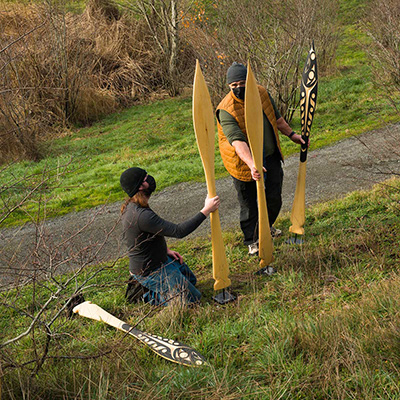 Is there anything else that you would like to add about the significance of Grandfather's Wisdom, carving, or any other current projects?
Is there anything else that you would like to add about the significance of Grandfather's Wisdom, carving, or any other current projects?
I think as an artist, just a piece of advice for anybody that's getting into public art is to have an open mind and take all the help you can get. Then you'll figure out what works for you. Knowing that there are people who can say these are good engineers or these are good installers. And just remember there's no stupid question, you know, only the one you don't ask. That's probably the best advice I could give: just ask the question.
Interview responses have been edited for print. A recording of the full conversation can be accessed via Sound Cloud.
All images: Andrea Wilbur-Sigo. Grandfather’s Wisdom (in process), 2020. Photos: Joe Freeman

